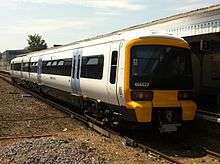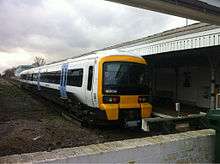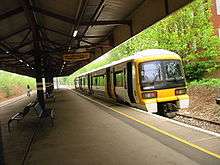British Rail Class 466
| British Rail Class 466 Networker | |
|---|---|
|
A southeastern class 466 in the new blue livery | |
| In service | 1993 – Present |
| Manufacturer | GEC Alsthom (Metro-Cammell) |
| Family name | Networker |
| Replaced | |
| Constructed | 1993–1994[1] |
| Refurbishment |
|
| Number built | 43 trainsets |
| Formation | Two cars per trainset[1] |
| Fleet numbers | 466001 - 466043 |
| Capacity | 168 Standard seats[1] |
| Operator(s) | Southeastern |
| Specifications | |
| Car length |
|
| Width | 2.81 m (9 ft 2 5⁄8 in)[1] |
| Height | 3.77 m (12 ft 4 3⁄8 in) |
| Maximum speed | 75 mph (121 km/h)[1] |
| Weight | Total - 72.4 t (71.3 long tons; 79.8 short tons) |
| Power output | 804 hp (600 kW) |
| Electric system(s) | 750 V DC third rail |
| Current collection method | Contact shoe |
| Track gauge | 1,435 mm (4 ft 8 1⁄2 in) standard gauge |

The British Rail Class 466 Networker electric multiple units were built by GEC Alsthom (Metro-Cammell) between 1993 and 1994, which operates with Class 465 EMUs in southeast London and Kent on the Southeastern network. It is a member of the Networker family of trains.
Description
The Class 466 EMUs were built between 1993 and 1994 by GEC Alsthom in Birmingham, for the Network SouthEast sector of British Rail.[2] They were inherited by Connex South Eastern and its successors South Eastern Trains and currently Southeastern. Each of these units is formed of two coaches that have dimensions of 20.89 m × 2.81 m (68 ft 6 in × 9 ft 3 in) and a top speed of 75 mph (121 km/h).[2] There are just 43 units, numbered 466001 to 466043.
Class 466 units are used by Southeastern Metro routes in multiple with Class 465/0, Class 465/1, Class 465/2 and other Class 466 units. Additionally, Class 466 units are now also operating on outer suburban routes with Class 465/9 units, although quite a few routes are being replaced with Class 375 Electrostars. They are also used as individual units on rural routes, mainly the Sheerness Line between Sittingbourne and Sheerness, displacing the Class 508/2s which operated on this branch line and on the Bromley North branch between Grove Park and Bromley North.
The Class 466s were also used on the Medway Valley Line between Strood, Maidstone West and Tonbridge, and in the leaf fall and winter season of 2011, the Class 466s were doubled up to make 4 car units on the Medway Valley Line to help stop the poor adhesion along the line when only a single unit runs. They also ran doubled up or coupled with a Class 465 on the Sheerness Line during the winters of 2009/10 and 2010/11. From the May 2012 timetable changes, Class 375s replaced the Class 466s on the Medway Valley Line. The units that replaced them were three car Class 375/3s and occasionally four car Class 375s are used when the three coach units are unavailable.
These two-car EMUs are formed of a driving motor carriage (DMOS: Driving Motor Open Standard) and a driving trailer carriage (DTOSL: Driving Trailer Open Standard Lavatory); all on board seating is standard accommodation.[2] A Solid State Traction Converter package controls 3-phase AC Traction motors, which allows for Rheostatic or Regenerative Dynamic braking. Primary braking system is electro-pneumatically actuated disc brakes, which is blended with the Dynamic brakes. Speed Probes on every axle of the unit provide for Wheel Slip/Slide Protection. A solid state Auxiliary Converter provides 110 V DC and 240 V AC supplies; this is the source of the loud buzzing noise which can be heard when the train is stationary. The Aux Converter is located on the driving trailer, along with the toilet. The units use air-operated sliding plug doors.
There are a total of 43 Class 466 EMUs on the UK rail network. These are all owned by Angel Trains, leased and operated by Southeastern. All these units have recently been fitted with new information boards with automatic announcements.
Refurbishment

The 466s were repainted at Wabtec Rail, Doncaster into a variation of Southeastern's new livery, which is identical to the livery the 465/0s & /1s received. All 43 units in the fleet are now in the new livery with lilac doors and midnight blue lower band. The 465/2s and /9s are also being repainted into the same livery. Some 465/2s and /9s still have not received the livery and are still being sent up to Doncaster for refurbishment to this day. Class 66 locos are used to haul the units to Doncaster.
Production and numbering

| Class | Introduced/Built | Manufacturer | Number Range | Comments |
|---|---|---|---|---|
| Class 466 | 1993-94 | GEC Alsthom (Metro-Cammell) | 466001-043 | - Repainted units: All units are now in the new southeastern livery. |
Fleet details
| Specification | Sub-class | ||||||
|---|---|---|---|---|---|---|---|
| 465/0 | 465/1 | 465/2 | 465/9 | 466 | |||
| Currently owned by: | Eversholt Rail Group | Eversholt Rail Group | Angel Trains | Angel Trains | Angel Trains | ||
| Operated by: | Southeastern | ||||||
| Routes used on: | Metro & Outer Suburban | Metro & Outer Suburban | Metro & Outer Suburban | Outer Suburban | Metro, Outer Suburban & Branch Lines | ||
| Built: | 1991–1993 by BREL York | 1993–1994 by ABB York | 1991–1993 by GEC Alsthom (Metro-Cammell), Washwood Heath | 1991-1993 by GEC Alsthom (Metro-Cammell), Washwood Heath Refurbished 2005 by Wabtec, Doncaster |
1993–1994 by GEC Alsthom (Metro-Cammell), Washwood Heath | ||
| Formation: | DMOS(A)-TOS-TOSL-DMOS(B) | DMOC(A)-TOS-TOSL-DMOC(B) | DMOS-DTOSL | ||||
| Construction: | Welded aluminium alloy | ||||||
| Doors: | Air powered sliding plug | ||||||
| Gangways: | Within 4-coach unit only | Within 2-coach unit only | |||||
| Electrical Equipment: | Hitachi IGBT inverter technology | GTO inverters | |||||
| Traction motors: | Four Brush TIM970 three-phase induction motors of 280 kW | GEC-Alsthom G352AY three-phase induction motors of 280 kW | |||||
| Couplers: | Tightlock (with underslung electrical/air connector box) | ||||||
| Suspension: | Primary: spring Secondary: airbag | ||||||
| Bogies: | BREL P3/T3 | SRP BP62/BT52 | BREL P3/T3 | ||||
| Maximum speed: | 75 mph (121 km/h) | ||||||
| Dimensions: | 20.89 or 20.06 m (68 ft 6 in or 65 ft 10 in) × 2.81 m (9 ft 3 in) | ||||||
| Train brakes: | Primary: Disc, Secondary: Rheostatic (and Regenerative capable but currently not used) | ||||||
| Mass: | 28.6–38.9 tonnes (28.1–38.3 long tons; 31.5–42.9 short tons) | ||||||
| Multiple working: | Within Class 365, Class 465 and Class 466. Additionally Class 319 by use of Coupling Changeover Switch for Assistance/Rescue purposes in the Thameslink corridor only. | ||||||
February 2007 collision
From the RAIB report:[3]
On 5 February 2007 a bridge inspection unit working on the M20 was deployed over a railway bridge between Maidstone Barracks and Aylesford stations. The gantry on the bridge inspection unit was struck by a scheduled passenger train, causing significant damage to the leading carriage and wrecking the gantry. The train driver and the sole passenger were slightly injured. Nobody was on the gantry at the time.
At 22:25 hrs on 5 February 2007 Southeastern train 2T83, the 21:57 hrs Paddock Wood to Gillingham (Kent) struck the "Moog" gantry which was foul of the up line. The train was a 2 car electric unit of class 466 (466041) and was carrying a driver and one passenger.
The collision speed was 65 mph (105 km/h). The leading carriage suffered substantial damage to the cab and forward saloon areas. The driving cab roof was ripped open at the right hand side.
References
- 1 2 3 4 5 6 466 - GEC-ALSTOM - Angel Trains. Retrieved 9 April 2013.
- 1 2 3 Classes 465 and 466 - Welcome to the Southern E-Group Web Site. Retrieved 17 December 2010
- ↑ "Collision between a train and a road vehicle, M20 overline bridge, Aylesford" (PDF). RAIB. September 2007. Retrieved 3 March 2011.
External links
| Wikimedia Commons has media related to British Rail Class 466. |
